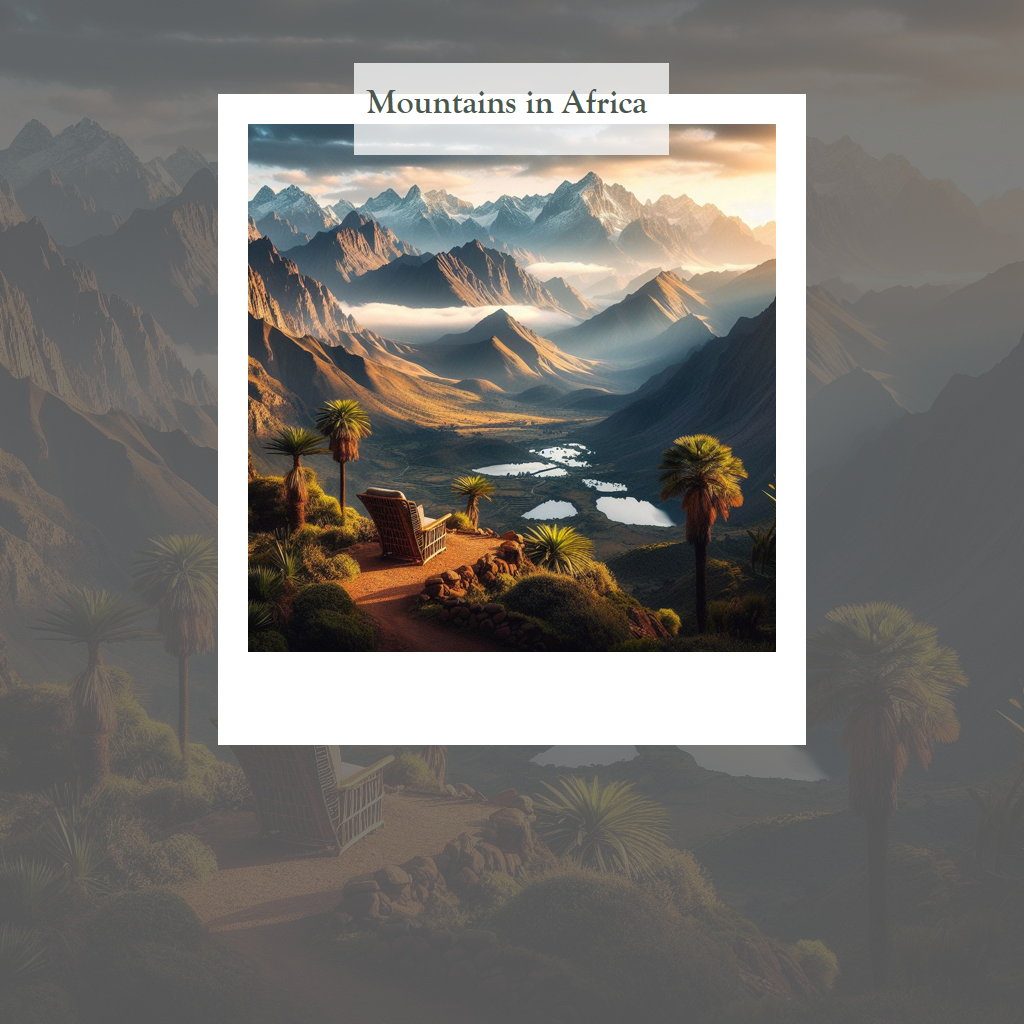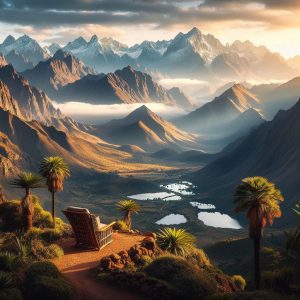Exploring the Majestic Mountains in Africa: An Armchair Adventure Awaits
As a self-proclaimed aficionado of rugged mountain adventures, few things ignite my imagination like the dramatic peaks and valleys across Africa’s diverse landscapes. From summiting Kilimanjaro as the glowing orange sunrise illuminated miles of open plains below to close encounters with lively Berber villages scattered through Morocco’s ancient Atlas range, I’ve had the privilege to traverse many of the continent’s legendary highlands.
In my experience, photographs can never quite capture the sensational feeling of arriving at a peak’s precipice to be greeted by miles of unbroken views in every direction. Nor the adrenaline rush of tackling a rocky knife-edge trail with sheer cliffs plunging hundreds of feet just inches from your boots.
The unique personalities of Africa’s mountain cultures and exotic wildlife encounters lurking around every corner bring further intrigue, cementing these destinations as my absolute favorite places to journey as a travel writer.
In this blog, I want to provide a glimpse into three particularly remarkable African mountain ranges that should be on every nature lover and armchair adventurer’s bucket list.
We’ll traverse the “rooftop” of Kilimanjaro, which typifies the grandiosity and glamour that often comes to mind when picturing the continent’s peaks. Then navigate the Berber villages scattered through Morocco’s High Atlas range to reveal a more intimate side of mountain life. Lastly, we’ll summit beloved Table Mountain which stands as an iconic sentinel over what many consider Africa’s most beautiful city. Trust me when I say each range has adventures galore in store!
The Roof of Africa: Climbing Mount Kilimanjaro
At 19,341 feet, the majestic Mount Kilimanjaro needs no introduction as its snowy domed summit is likely the prototypical African mountain vista burned into your imagination. Part of the larger Kilimanjaro massif straddling the Kenya-Tanzania border, this towering inactive stratovolcano is the continent’s tallest, as well as the highest single free-standing mountaintop on the planet.
As an ambitious peak-bagger always hungry for new heights and views to discover, I simply couldn’t resist the siren call to summit Kilimanjaro. Just gazing upon it from the surrounding Amboseli and Tsavo parks, seeing its towering massif bursting from the plains, I knew reaching Uhuru Peak would offer perspective unlike anywhere else.
And I was right – my memory of watching the first rays of sunshine cascade down the steep Shira plateau cliffs in a glowing cascade while standing literally on the roof of Africa will stay etched in my mind forever.
But Kilimanjaro should be on every traveler’s wishlist not just for its superlative credentials but for the unparalleled diversity of vistas and experiences to be had. Unlike many peaks attempting Kili involves no technical mountaineering skills, instead following relatively straightforward (though still taxing) hiking trails. And what trails they are! The various routes transverse ecosystems ranging from dense equatorial jungle to frigid arctic-alpine, sometimes in a single day’s journey.
Just imagine sauntering through lush cloud forests overflowing with furry Colobus monkeys and exotic birds in the morning, taking a lunch break beside elephant tracks in the savanna grasslands, and afternoon traversing the alien arctic tundra landscapes blanketed under ice and snow.
Reaching the top means joining the less than 50% of challengers who successfully summit Kilimanjaro each year. Though moderate fitness levels and proper acclimatization planning can see most hikers through to Uhuru, it’s no casual walk in the park. But every bit of effort pays off handsomely once your eyes drink in 360° views in literally every direction from the peak’s perch.
As morning rays glinted off the distant glaciers surrounding us, I’ll never forget spotting the tiny striated triangles of wildebeest herds below migrating across the Serengeti to escape the growing heat – it was a mesmerizing snapshot of raw natural beauty. With memories and perspective for a lifetime under your belt, climbing down feels like returning home from another world entirely.
The Atlas Mountains: Where Continents Collide
But as extraordinary as Kilimanjaro fills every sense, I’m constantly amazed by how little many travelers think of the Atlas Mountain chains snaking across Northwest Africa. Here, the striking panoramas and human resilience found amidst the peaks and valleys leave an equally profound impression as anywhere on the continent.
Forming the impressive backbone of Morocco, Algeria, and Tunisia, these folded mountain chains quite literally form from the collision point and grinding of the African and Eurasian tectonic plates. Constant seismic pressures continue to thrust these peaks skyward – meaning the region frequently shakes with earthquakes as new ridges threateningly emerge.
While composed of several named sub-chains, I prefer rubbing shoulders with tiny rural villages that populate the tradition-rich Berber communities in the High Atlas range. After sweating my way through the consumer chaos of Marrakech, escaping into tiny mountain villages barely touched by outside influence provided the perfect juxtaposition.
I’ll never forget the smiling farmer families who welcomed myself and my guide into their semi-fortified adobe and stone homes built directly into the mountainsides. Making our introductions over sweet mint tea as curious children giggled at our strange trekking clothes and gear felt like entering a different world.
Later summiting Jebel Toubkal, the 13,671 ft apex of the High Atlas, the seemingly endless ridges of North Africa’s greatest mountain system fanned out as far as my eye could see. Here the arid beauty glancing south at the world’s greatest desert, the vast Sahara, clashing dramatically against the snowbound peaks in the other direction crystallized why I feel permanently intoxicated by rugged African panoramas. They simply overwhelm your senses unlike anywhere else!
Mountains in Africa: Table Mountain and Cape Town
While legendary peaks like Kilimanjaro and Toubkal might impress in sheer awe-inspiring scale, South Africa’s iconic flat-topped Table Mountain offers an equally entrancing allure that captivated me just the same.
Whether approached from the undulating vineyards blanketing its slopes or the world-famous Cape Town city streets sprawling at its feet, spotting Table Mountain’s unique plateaued profile draws your attention instantly. Recognized as one of the world’s most photographed vistas, my first glimpse at the 3,558 ft monolith felt like visual nirvana – there’s simply no landscape quite so recognizable etched against the skies anywhere.
As spectacular to admire from below during my jaunts through Cape Town, it’s getting atop the plateau by foot or the rotating cable cars that really pay the sweeping views forward. Gazing down over the metropolis, national park forests, and coastlines fame below made it clear why locals proudly claim this the fairest Cape of all.
Though surrounded by incredible scenery wherever one wanders, Table Mountain centrally anchors this intoxicating paradise whether you’re seeking isolated non-technical summit treks, relaxing beach hangs, or sampling your way through world-class winery estates all within eyeshot of that majestic rocky edifice.
Standing atop one of the infamous boozy Long Street nightlife venues later under the stars with Table Mountain illuminated ethereally at night by the waxing moon above the city, I don’t think heaven on earth could manifest any clearer anywhere else!
Conclusion: Adventure is Calling!
Hopefully, this virtual trek has provided just a small glimpse into the treasures Africa’s mountains offer seekers of breathtaking vistas. These highlands gripped my imagination through their arresting beauty and the fascinating cultural experiences found while winding my way into their inner recesses.
Even after returning home, reminiscing on starry nights spent in Berber shepherd outposts, tracking elusive rhinos across Kilimanjaro’s dusty foothills, and drinking world-famous vintages while Table Mountain floated hazily in the background, my heart feels irretrievably tied to African mountain life unlike anywhere else.
So if striking, otherworldly panoramas and intimate cultural encounters pique your curiosity too, it’s time to don some hiking boots and satiate your inner adventurer. Trust me – after even just one safari into Africa’s high-altitude kingdoms, you may just find a second home waiting atop her soaring peaks!
Now over to you – which alluring “mountains in Africa” landscapes call most loudly for you to explore them first? Let me know in the comments below!
References:
- Wikipedia contributors. “Mount Kilimanjaro.” Wikipedia, The Free Encyclopedia. Wikipedia, The Free Encyclopedia
- Wexas Travel. “Trekking the Atlas Mountains in Morocco | Wexas.” Wexas Travel. https://www.wexas.com/inspiration/trekking-the-atlas-mountains-in-morocco.
- South African Tourism. ““Explore Table Mountain National Park in Cape Town.” South African Tourism. https://www.southafrica.net/za/en/places/cape-town/table-mountain-national-park




